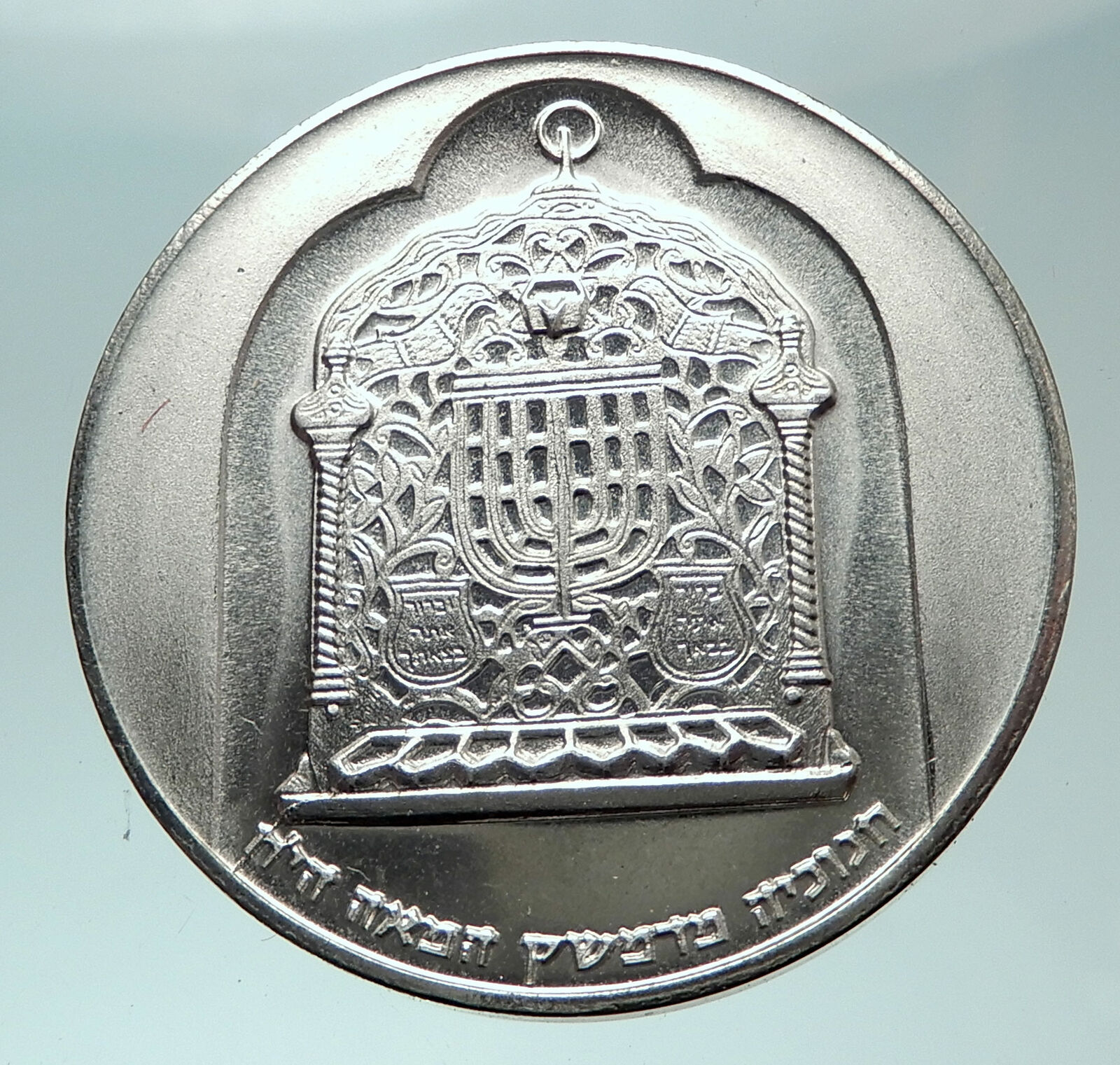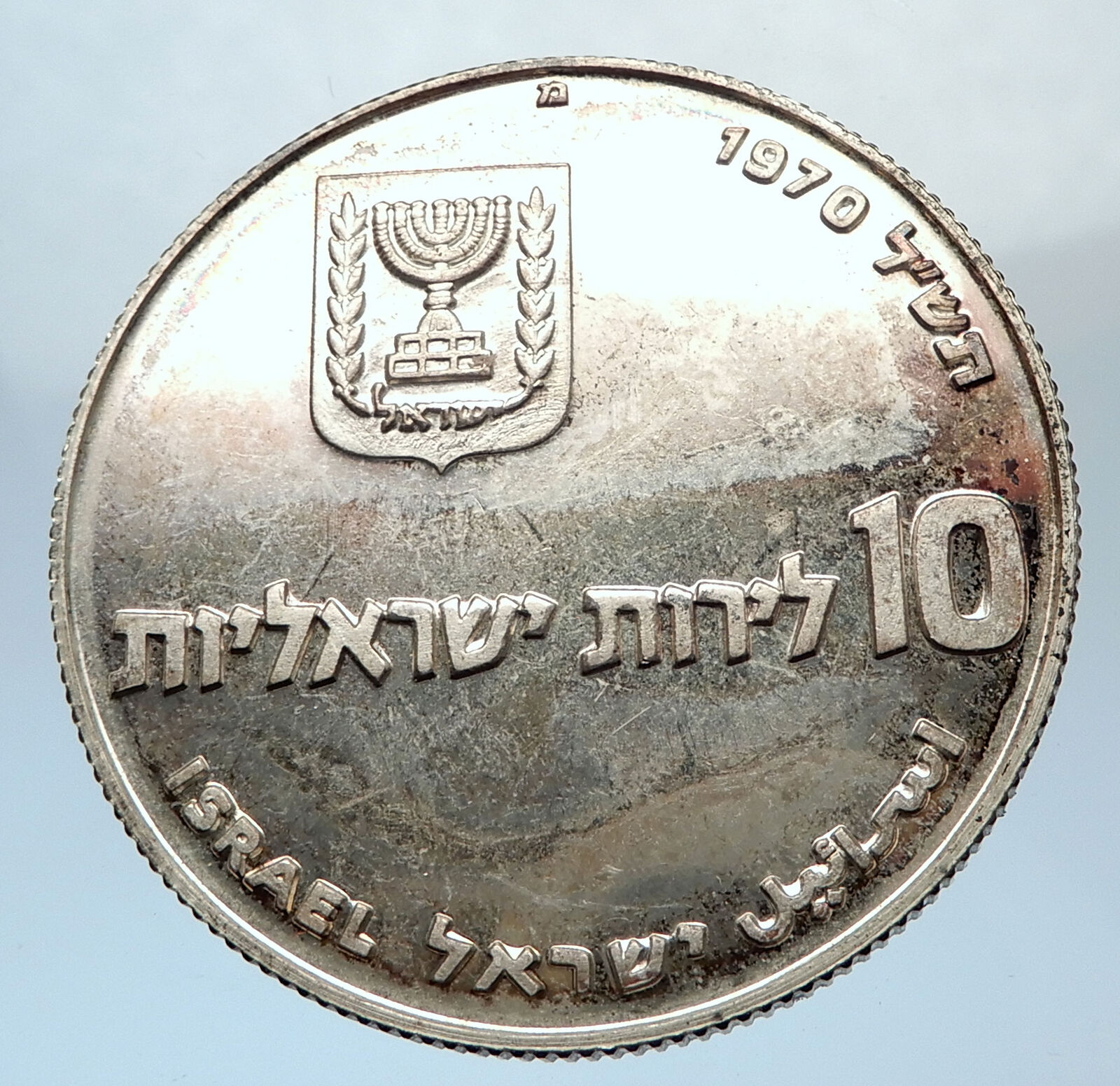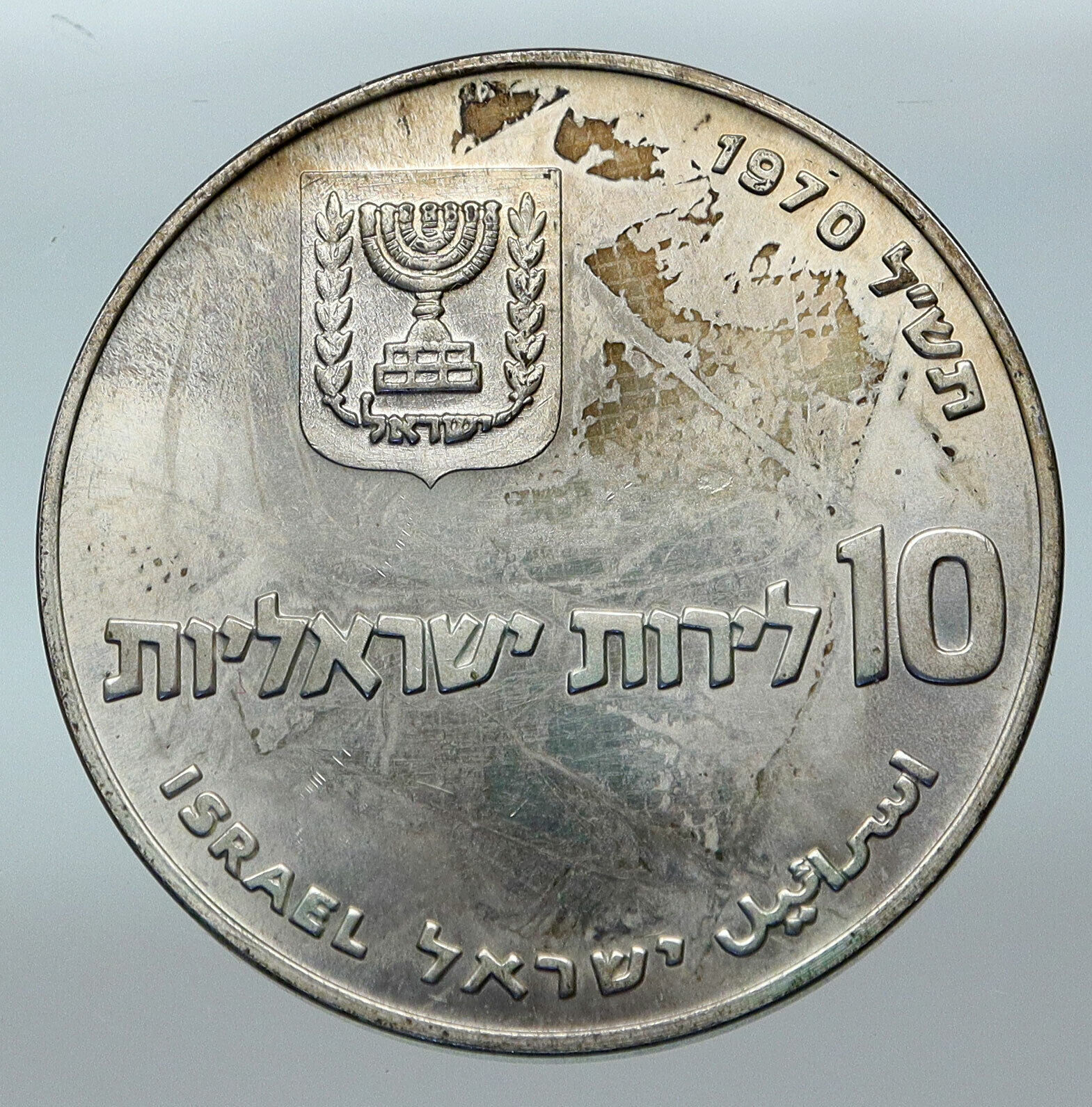|
Israel – Hannukah Lamp Series – Theresienstadt Camp
1984
BU Silver New Sheqel 30mm (14.40 grams) 0.850 Silver (0.3935 oz. ASW)
Reference: KM# 144 | Engraver: Gideon Keich
ISRAEL ישראל اسرائيل 1 שקל 1984 התשמ , Stylized denomination above Seal of Israel (Menorah), representing strips of metal used for the Menorah.
חנוכיה, Hanukka Lamp from the Theresienstadt Ghetto and the inscription in Hebrew and in English : Hanukka Lamp from Theresienstadt Ghetto 24.11.1941-9.5.1945
Coin Notes:
In 1981, a most unusual Hanukka Lamp was presented to the “Yad Vashem” Museum by an anonymous American donor. The distinguishing feature of this Hanukka Lamp was not its external beauty but rather its great historical value. Its craftsman was unknown but it was made from automobile spare parts and scrap-iron from the Theresienstadt Ghetto garage. It had been discovered in Europe after the war and taken to the United States.
Of all the ghettos and concentration camps set up by the Germans, Theresienstadt was different. The Nazis wished to create a sort of model “Jewish City” governed by its inhabitants.
Bohemian and Moravian Jews, who numbered 118,000 before the Holocaust, never suspected that Theresienstadt was going to be a staging point on the way to Poland rather than a survival point, as the Germans had tried to indicate. In spite of inhuman living conditions, the inhabitants of Theresienstadt succeeded in maintaining their human dignity, as well as a flourishing and artistic life. They even presented plays in Czech and in German. Tragically, out of 150,000, about 30,000 of the inhabitants perished in the Ghetto, while about 90,000 were sent to Auschwitz and exterminated in the ovens of the concentration camps. The Hanukka Lamp from Theresienstadt is a remaining tangible symbol of this heroic chapter in the history of the Jewish people during the Holocaust.
You are bidding on the exact item pictured, provided with a Certificate of Authenticity and Lifetime Guarantee of Authenticity.
 Theresienstadt was a hybrid concentration camp and ghetto established by the SS during World War II in the fortress town Terezín, located in the Protectorate of Bohemia and Moravia (a German-occupied region of Czechoslovakia). Theresienstadt served two main purposes: it was simultaneously a waystation to the extermination camps, and a “retirement settlement” for elderly and prominent Jews to mislead their communities about the Final Solution. Its conditions were deliberately engineered to hasten the death of its prisoners, and the ghetto also served a propaganda role. Unlike other ghettos, the exploitation of forced labor was not economically significant. Theresienstadt was a hybrid concentration camp and ghetto established by the SS during World War II in the fortress town Terezín, located in the Protectorate of Bohemia and Moravia (a German-occupied region of Czechoslovakia). Theresienstadt served two main purposes: it was simultaneously a waystation to the extermination camps, and a “retirement settlement” for elderly and prominent Jews to mislead their communities about the Final Solution. Its conditions were deliberately engineered to hasten the death of its prisoners, and the ghetto also served a propaganda role. Unlike other ghettos, the exploitation of forced labor was not economically significant.
The ghetto was established by a transport of Czech Jews in November 1941. The first German and Austrian Jews arrived in June 1942; Dutch and Danish Jews came beginning in 1943 and prisoners of a wide variety of nationalities were sent to Theresienstadt in the last months of the war. About 33,000 people died at Theresienstadt, mostly from malnutrition and disease. More than 88,000 people were held there for months or years before being deported to extermination camps and other killing sites; the Jewish self-administration’s role in choosing those to be deported has attracted significant controversy. Including 4,000 of the deportees who survived, the total number of survivors was around 23,000.
Theresienstadt was known for its relatively rich cultural life, including concerts, lectures, and clandestine education for children. The fact that it was governed by a Jewish self-administration as well as the large number of “prominent” Jews imprisoned there facilitated the flourishing of cultural life. This spiritual legacy has attracted the attention of scholars and sparked interest in the ghetto. In the postwar period, a few of the SS perpetrators and Czech guards were put on trial, but the ghetto was generally forgotten by the Soviet authorities. The Terezín Ghetto Museum is visited by 250,000 people each year.
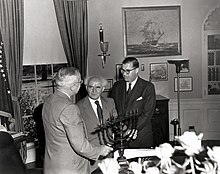 The Hanukkah menorah, also chanukiah or hanukkiah (Hebrew: מנורת חנוכה menorat ḥanukkah, pl. menorot; also Hebrew: חַנֻכִּיָּה ḥanukkiyah, or chanukkiyah, pl. ḥanukkiyot/chanukkiyot, or Yiddish: חנוכּה לאָמפּ khanike lomp, lit.: Hanukkah lamp), is a nine-branched candelabrum lit during the eight-day holiday of Hanukkah. Eight of the nine branches hold lights (candles or oil lamps) that symbolize the eight nights of the holiday; on each night, one more light is lit than the previous night, until on the final night all eight branches are ignited. The ninth branch holds a candle, called the shamash, used to light the other eight. The Hanukkah menorah, also chanukiah or hanukkiah (Hebrew: מנורת חנוכה menorat ḥanukkah, pl. menorot; also Hebrew: חַנֻכִּיָּה ḥanukkiyah, or chanukkiyah, pl. ḥanukkiyot/chanukkiyot, or Yiddish: חנוכּה לאָמפּ khanike lomp, lit.: Hanukkah lamp), is a nine-branched candelabrum lit during the eight-day holiday of Hanukkah. Eight of the nine branches hold lights (candles or oil lamps) that symbolize the eight nights of the holiday; on each night, one more light is lit than the previous night, until on the final night all eight branches are ignited. The ninth branch holds a candle, called the shamash, used to light the other eight.
The Hanukkah menorah commemorates, but is distinct from, the seven-branched menorah used in the ancient Temple in Jerusalem. The hanukkiah, along with the seven-branched menorah and the Star of David, is among the most widely produced articles of Jewish ceremonial art.
The hanukkiah is often displayed in public around Hanukkah time in December. Elected officials often participate in publicly lighting the hanukkiah. The Chabad-Lubavitch movement is well associated with public lighting ceremonies, which it has done since a directive from their last Rebbe, Menachem Mendel Schneerson, in 1987. In the book A Kosher Christmas: ‘Tis the Season to Be Jewish, author Rabbi Joshua Plaut, Ph.D. details the history of public displays of the hanukkiah across the United States, summarizes the court cases associated with this issue, and explains how Presidents of the United States came to embrace lighting the hanukkiah during Hanukkah.
In the US, the White House has been represented at the lighting of the National Menorah since 1979. This celebration of Hanukkah began with the attendance of President Jimmy Carter in the ceremony in Lafayette Park. Additionally, beginning with President Bill Clinton in 1993, a hanukkiah is lit at the White House, and in 2001, President George W. Bush began the annual tradition of a White House Hanukkah Party in the White House residence, which includes a hanukkiah candle lighting ceremony.
In the United Kingdom, the House of Commons of the United Kingdom each year holds a hanukkiah lighting at the official residence of the Speaker of the House of Commons, located in the Palace of Westminster. The hanukkiah currently used was commissioned by the Rt. Hon. Michael Martin MP, then Speaker of the House of Commons. Martin is a Roman Catholic; his successor, John Bercow, was coincidentally the first Jewish Speaker of the House of Commons.
Two large hanukkiahs are in New York City, each standing at 32 feet. One is at Grand Army Plaza in Brooklyn, and the other is at Fifth Avenue and 59th Street in Manhattan near Central Park. A 4,000-pound structure, it is the work of Israeli artist Yaacov Agam. Because of the hanukkiah’s height, Con Edison assists the lighting by using a crane to lift each person to the top.
 Israell (/ˈɪzriəl, ˈɪzreɪəl/; Hebrew: יִשְׂרָאֵל; Arabic: إِسْرَائِيل), officially the State of Israel, is a country in the Middle East, on the southeastern shore of the Mediterranean Sea and the northern shore of the Red Sea. It has land borders with Lebanon to the north, Syria to the northeast, Jordan on the east, the Palestinian territories of the West Bank and Gaza Strip to the east and west, respectively, and Egypt to the southwest. The country contains geographically diverse features within its relatively small area. Israel’s economic and technological center is Tel Aviv, while its seat of government and proclaimed capital is Jerusalem, although the state’s sovereignty over Jerusalem has only partial recognition. Israell (/ˈɪzriəl, ˈɪzreɪəl/; Hebrew: יִשְׂרָאֵל; Arabic: إِسْرَائِيل), officially the State of Israel, is a country in the Middle East, on the southeastern shore of the Mediterranean Sea and the northern shore of the Red Sea. It has land borders with Lebanon to the north, Syria to the northeast, Jordan on the east, the Palestinian territories of the West Bank and Gaza Strip to the east and west, respectively, and Egypt to the southwest. The country contains geographically diverse features within its relatively small area. Israel’s economic and technological center is Tel Aviv, while its seat of government and proclaimed capital is Jerusalem, although the state’s sovereignty over Jerusalem has only partial recognition.

Israel has evidence of the earliest migration of hominids out of Africa. Canaanite tribes are archaeologically attested since the Middle Bronze Age, while the Kingdoms of Israel and Judah emerged during the Iron Age. The Neo-Assyrian Empire destroyed Israel around 720 BCE. Judah was later conquered by the Babylonian, Persian and Hellenistic empires and had existed as Jewish autonomous provinces. The successful Maccabean Revolt led to an independent Hasmonean kingdom by 110 BCE, which in 63 BCE however became a client state of the Roman Republic that subsequently installed the Herodian dynasty in 37 BCE, and in 6 CE created the Roman province of Judea. Judea lasted as a Roman province until the failed Jewish revolts resulted in widespread destruction, expulsion of Jewish population and the renaming of the region from Iudaea to Syria Palaestina.[34] Jewish presence in the region has persisted to a certain extent over the centuries. In the 7th century the Levant was taken from the Byzantine Empire by the Arabs and remained in Muslim control until the First Crusade of 1099, followed by the Ayyubid conquest of 1187. The Mamluk Sultanate of Egypt extended its control over the Levant in the 13th century until its defeat by the Ottoman Empire in 1517. During the 19th century, national awakening among Jews led to the establishment of the Zionist movement in the diaspora followed by waves of immigration to Ottoman and later British Palestine.
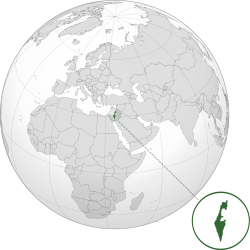 In 1947, the United Nations adopted a Partition Plan for Palestine recommending the creation of independent Arab and Jewish states and an internationalized Jerusalem. The plan was accepted by the Jewish Agency, and rejected by Arab leaders. The following year, the Jewish Agency declared the independence of the State of Israel, and the subsequent 1948 Arab-Israeli War saw Israel’s establishment over most of the former Mandate territory, while the West Bank and Gaza were held by neighboring Arab states. Israel has since fought several wars with Arab countries, and it has since 1967 occupied territories including the West Bank, Golan Heights and the Gaza Strip (still considered occupied after 2005 disengagement, although some legal experts dispute this claim). It extended its laws to the Golan Heights and East Jerusalem, but not the West Bank. Israel’s occupation of the Palestinian territories is the world’s longest military occupation in modern times. Efforts to resolve the Israeli-Palestinian conflict have not resulted in a final peace agreement. However, peace treaties between Israel and both Egypt and Jordan have been signed. In 1947, the United Nations adopted a Partition Plan for Palestine recommending the creation of independent Arab and Jewish states and an internationalized Jerusalem. The plan was accepted by the Jewish Agency, and rejected by Arab leaders. The following year, the Jewish Agency declared the independence of the State of Israel, and the subsequent 1948 Arab-Israeli War saw Israel’s establishment over most of the former Mandate territory, while the West Bank and Gaza were held by neighboring Arab states. Israel has since fought several wars with Arab countries, and it has since 1967 occupied territories including the West Bank, Golan Heights and the Gaza Strip (still considered occupied after 2005 disengagement, although some legal experts dispute this claim). It extended its laws to the Golan Heights and East Jerusalem, but not the West Bank. Israel’s occupation of the Palestinian territories is the world’s longest military occupation in modern times. Efforts to resolve the Israeli-Palestinian conflict have not resulted in a final peace agreement. However, peace treaties between Israel and both Egypt and Jordan have been signed.
In its Basic Laws, Israel defines itself as a Jewish and democratic state. Israel is a representative democracy.
|





 Theresienstadt was a hybrid concentration camp and ghetto established by the SS during World War II in the fortress town Terezín, located in the Protectorate of Bohemia and Moravia (a German-occupied region of Czechoslovakia). Theresienstadt served two main purposes: it was simultaneously a waystation to the extermination camps, and a “retirement settlement” for elderly and prominent Jews to mislead their communities about the Final Solution. Its conditions were deliberately engineered to hasten the death of its prisoners, and the ghetto also served a propaganda role. Unlike other ghettos, the exploitation of forced labor was not economically significant.
Theresienstadt was a hybrid concentration camp and ghetto established by the SS during World War II in the fortress town Terezín, located in the Protectorate of Bohemia and Moravia (a German-occupied region of Czechoslovakia). Theresienstadt served two main purposes: it was simultaneously a waystation to the extermination camps, and a “retirement settlement” for elderly and prominent Jews to mislead their communities about the Final Solution. Its conditions were deliberately engineered to hasten the death of its prisoners, and the ghetto also served a propaganda role. Unlike other ghettos, the exploitation of forced labor was not economically significant. The Hanukkah menorah, also chanukiah or hanukkiah (Hebrew: מנורת חנוכה menorat ḥanukkah, pl. menorot; also Hebrew: חַנֻכִּיָּה ḥanukkiyah, or chanukkiyah, pl. ḥanukkiyot/chanukkiyot, or Yiddish: חנוכּה לאָמפּ khanike lomp, lit.: Hanukkah lamp), is a nine-branched candelabrum lit during the eight-day holiday of Hanukkah. Eight of the nine branches hold lights (candles or oil lamps) that symbolize the eight nights of the holiday; on each night, one more light is lit than the previous night, until on the final night all eight branches are ignited. The ninth branch holds a candle, called the shamash, used to light the other eight.
The Hanukkah menorah, also chanukiah or hanukkiah (Hebrew: מנורת חנוכה menorat ḥanukkah, pl. menorot; also Hebrew: חַנֻכִּיָּה ḥanukkiyah, or chanukkiyah, pl. ḥanukkiyot/chanukkiyot, or Yiddish: חנוכּה לאָמפּ khanike lomp, lit.: Hanukkah lamp), is a nine-branched candelabrum lit during the eight-day holiday of Hanukkah. Eight of the nine branches hold lights (candles or oil lamps) that symbolize the eight nights of the holiday; on each night, one more light is lit than the previous night, until on the final night all eight branches are ignited. The ninth branch holds a candle, called the shamash, used to light the other eight. Israell (/ˈɪzriəl, ˈɪzreɪəl/; Hebrew: יִשְׂרָאֵל; Arabic: إِسْرَائِيل), officially the State of Israel, is a country in the Middle East, on the southeastern shore of the Mediterranean Sea and the northern shore of the Red Sea. It has land borders with Lebanon to the north, Syria to the northeast, Jordan on the east, the Palestinian territories of the West Bank and Gaza Strip to the east and west, respectively, and Egypt to the southwest. The country contains geographically diverse features within its relatively small area. Israel’s economic and technological center is Tel Aviv, while its seat of government and proclaimed capital is Jerusalem, although the state’s sovereignty over Jerusalem has only partial recognition.
Israell (/ˈɪzriəl, ˈɪzreɪəl/; Hebrew: יִשְׂרָאֵל; Arabic: إِسْرَائِيل), officially the State of Israel, is a country in the Middle East, on the southeastern shore of the Mediterranean Sea and the northern shore of the Red Sea. It has land borders with Lebanon to the north, Syria to the northeast, Jordan on the east, the Palestinian territories of the West Bank and Gaza Strip to the east and west, respectively, and Egypt to the southwest. The country contains geographically diverse features within its relatively small area. Israel’s economic and technological center is Tel Aviv, while its seat of government and proclaimed capital is Jerusalem, although the state’s sovereignty over Jerusalem has only partial recognition.
 In 1947, the United Nations adopted a Partition Plan for Palestine recommending the creation of independent Arab and Jewish states and an internationalized Jerusalem. The plan was accepted by the Jewish Agency, and rejected by Arab leaders. The following year, the Jewish Agency declared the independence of the State of Israel, and the subsequent 1948 Arab-Israeli War saw Israel’s establishment over most of the former Mandate territory, while the West Bank and Gaza were held by neighboring Arab states. Israel has since fought several wars with Arab countries, and it has since 1967 occupied territories including the West Bank, Golan Heights and the Gaza Strip (still considered occupied after 2005 disengagement, although some legal experts dispute this claim). It extended its laws to the Golan Heights and East Jerusalem, but not the West Bank. Israel’s occupation of the Palestinian territories is the world’s longest military occupation in modern times. Efforts to resolve the Israeli-Palestinian conflict have not resulted in a final peace agreement. However, peace treaties between Israel and both Egypt and Jordan have been signed.
In 1947, the United Nations adopted a Partition Plan for Palestine recommending the creation of independent Arab and Jewish states and an internationalized Jerusalem. The plan was accepted by the Jewish Agency, and rejected by Arab leaders. The following year, the Jewish Agency declared the independence of the State of Israel, and the subsequent 1948 Arab-Israeli War saw Israel’s establishment over most of the former Mandate territory, while the West Bank and Gaza were held by neighboring Arab states. Israel has since fought several wars with Arab countries, and it has since 1967 occupied territories including the West Bank, Golan Heights and the Gaza Strip (still considered occupied after 2005 disengagement, although some legal experts dispute this claim). It extended its laws to the Golan Heights and East Jerusalem, but not the West Bank. Israel’s occupation of the Palestinian territories is the world’s longest military occupation in modern times. Efforts to resolve the Israeli-Palestinian conflict have not resulted in a final peace agreement. However, peace treaties between Israel and both Egypt and Jordan have been signed. 

